What is igneous rock?
Igneous intrusions are a type of rock feature. They form when molten rock cools below the surface of the Earth.
In this article you can learn about:
- What igneous rock intrusions are
- How laccoliths and volcanic plugs form
- Where you can find igneous intrusive features
- Scottish wildlife in Lothian
This resource is suitable for Landscapes topics for primary school learners.
Video - Igneous rock landscapes
Join Isla and Connor as they explore igneous rock landscape features at Traprain Law, North Berwick Law and Bass Rock in East Lothian.
Watch this short video to find out what an igneous intrusion is and how it is formed.
CONNOR: Isn’t it strange how Traprain Law and North Berwick Law seem to just leap out of the flat ground here?
ISLA: Traprain Law is an unusual igneous intrusion called a laccolith.
Igneous intrusions form when molten rock, or magma, from deep underground pushes up towards the Earth’s surface but cools and solidifies before it gets there.
Some magma is super thick, so it can only force itself a short distance, sideways into a mushroom shape, pushing up the rock above before solidifying.
CONNOR: Just like at Edinburgh and Castle Rock!
ISLA: Yes, they’re all connected - part of the same volcanic mountain range.
CONNOR: Well that’s interesting, and almost as much fun as climbing them. Come on!
ISLA: Wow, that was hard work, but worth it for the view!
CONNOR: Look how flat the rest of the land is - it’s really fertile and good for farming.
ISLA: And look at the wildflowers! So beautiful. The fertile land must be why they grow so well.
CONNOR: Look over there, Isla, an Exmoor pony. They come all the way from the moors in Devon and Somerset in the southwest of England. They’ve been brought here to keep the grass cropped so those wildflowers can grow.
ISLA: Not a bad job, eating all day! Traprain Law is also famous for the largest hoard of Roman silver ever found outside the Roman Empire - so keep your eyes peeled, you never know what you’ll find.
CONNOR: Let’s go and explore North Berwick Law next…
Another unusual shape, isn’t it!
ISLA: Yes, because it’s a volcanic plug. A plug forms when molten lava and hot ash gets stuck as an upright gooey mess in the vent of a volcano. That’s the channel inside a volcano that opens up to the surface.
As it cools it becomes a very hard type of igneous rock. This one first formed over 350 million years ago.
Then, millions of years after that, during the last ice age - when the land was covered in ice and slow moving glaciers - the ice eroded, wore away, the softer surrounding land and some of the outer layers of the extremely hard rock volcanic plug.
That sculpted the rock, giving it the shape we can see today.
And more great views!
CONNOR: Wow! Bass Rock looks just like Treprain Law and North Berwick Law…but at sea!
ISLA: That’s right. It’s also an igneous intrusive feature, just like them.
The rock they’re made of is called phonolite - also called a ‘sounding stone’, it makes a metallic, resonant sound if hit with a hammer.
The rock is home to the world’s largest colony of Northern Gannets - about 150,000! The rock continues to be shaped by the wind and sea today.
This makes me wonder about other incredible landscapes by the sea - islands, coastlines. There’s so much out there to explore!
CONNOR: Definitely. I’m calling a beach day!
Igneous rock intrusive features
- An igneous intrusion is a type of rock feature that forms when magma Molten rock. cools below the surface of the Earth.
- Magma, from deep underground, pushes up towards the Earth’s surface, creating intrusions like laccoliths and volcanic plugs. The magma cools and solidifyWhen something becomes hard or solid. before it can reach the surface.
Learn more about igneous rock and other rock types with Isla and Connor: Rock types.
What is a laccolith?
Laccoliths are mushroom-shaped igneous intrusions. Thick magma forces its way upwards for a short distance then begins to move sideways. The magma cools down and solidifies, leaving behind a mound of rock, like Traprain Law.
How is a volcanic plug formed?
Volcanic plugs are another kind of igneous intrusive feature. They form when molten lava and hot ash get stuck inside the ventThe channel inside a volcano that opens up to the surface. of a volcano. As it cools down, it becomes very hard igneous rock, like North Berwick Law and Bass Rock.
Where can you find igneous intrusive features?
There are many interesting igneous intrusions in Edinburgh and Lothian. This map shows some of the most notable volcanic and igneous features in the area. If you live nearby, or visit the area, it could be fun to spot them!
Igneous intrusions around Scotland
Igneous intrusions can be found all around Scotland, not just in Edinburgh and Lothian.
Some other examples of igneous intrusions in Scotland can be found at Dumbarton Rock (a volcanic plug in Dumbarton) and Loudoun Hill (a volcanic plug in Ayrshire).
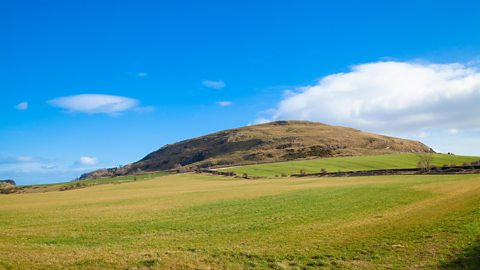
Image caption, Traprain Law
Traprain Law is a laccolith: a mushroom-shaped igneous intrusion. Magma forced its way up towards the Earth's surface then moved sideways before it cooled down and solidified. (Richard Newton / Alamy Stock Photo)
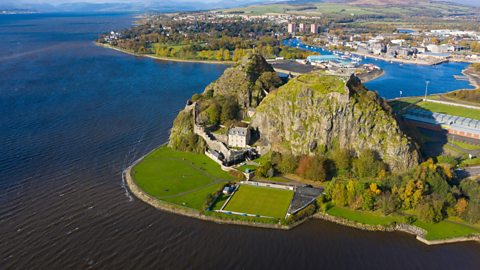
Image caption, Dumbarton Rock
Dumbarton Rock in West Dunbartonshire is a volcanic plug, which was created millions of years ago. The tall volcanic rock made it a great defensive location for Dumbarton Castle. (Iain Masterton / Alamy Stock Photo)

Image caption, Loudoun Hill
Loudoun Hill is a volcanic plug in East Ayrshire. A battle was fought here during the Scottish Wars of Independence and the fertile lands around the rock have been farmed for many generations. (Hugh Maxwell / Alamy Stock Photo)
1 of 3
Plants and animals in East Lothian
Learn more about some of the plants and animals that can be spotted near East Lothian's igneous intrusive features.
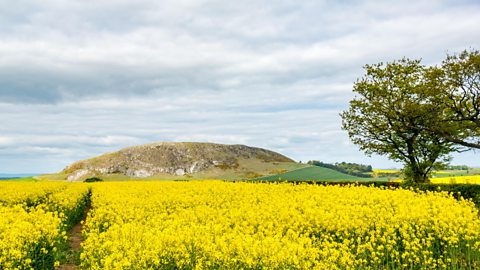
Image caption, Flowers and crops
The flat fertile land around Traprain Law helps flowers and crops grow, like this field of bright yellow oilseed rape. (Sally Anderson Weather / Alamy Stock Photo)
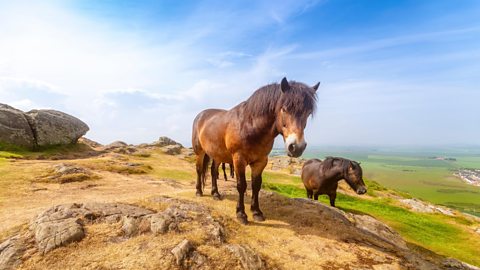
Image caption, Exmoor ponies
Traprain Law and North Berwick Law are home to Exmoor ponies. They were brought to the area from the moors in the southwest of England as part of a conservation grazing project. They roam freely around the land and keep the grass cropped so other plants, like wildflowers, can grow. (Westend61 GmbH / Alamy Stock Photo)
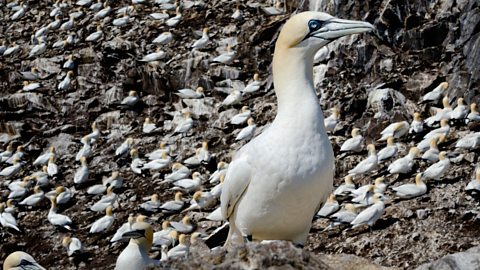
Image caption, Northern Gannets
Bass Rock is home to the world's largest colony of Northern Gannets. These seabirds dive into water at high speed to catch fish. (Clearview / Alamy Stock Photo)
1 of 3

Key words about igneous rock
- igneous intrusion - A type of rock feature that forms when magma (molten rock) cools below the surface of the Earth.
- magma - Molten rock that is so hot it has turned into liquid. When magma reaches the surface of the Earth it is called lava.
- laccolith - A mushroom-shaped body of igneous rock that forms under the surface of the Earth.
- mountain range - A series of hills or mountains that have formed close together.
- fertile - Soil or land that is good for producing lots of plants.
- volcanic plug - An igneous rock feature formed when molten lava and hot ash get stuck and harden inside the vent of a volcano.
- vent - The channel inside a volcano that opens up to the surface.
- glacier - A massive river of slow moving ice.
- erosion - Wearing away.
- Ice Age - A long period of time when the Earth's temperature became very low. The Earth's surface was buried under sheets of ice. It was at its peak about 22,000 years ago.
- phonolite - A type of rock also known as a 'sounding stone'.
Test your knowledge
Quiz
Challenge

Design some Roman treasure (like the silver found at Traprain Law)
Traprain Law is famous for the largest hoard of Roman silver ever found outside the Roman Empire.
Can you research the types of Roman objects that they might have found and design your own?
Watch this video to learn more about the Romans and what they left behind in Scotland.
More on Landscapes
Find out more by working through a topic
- count14 of 25

- count15 of 25

- count16 of 25

- count17 of 25

